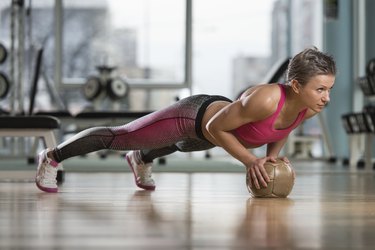
The scapula is the largest bone within the shoulder girdle and is normally held flat against your rib cage by your serratus anterior and rhomboid muscles. If theses muscles become stretched and/or weak, your scapula can lift -- a condition called winging. A winged scapula protrudes outward, and winging can occur to one or both scapula. Strengthening your serratus anterior and rhomboid muscles will stabilize your scapula and reduce winging.
Ball Circles Against a Wall
Video of the Day
Ball circles against a wall will strengthen your serratus anterior. This exercise also strengthens the rotator cuff muscles deep within your shoulders. Place and hold a stability ball against a wall at shoulder height. Position one hand on the apex of the ball and rest your other hand by your side. Keep your shoulders down and back. Make small circles with your hand while maintaining pressure on the ball. Work clockwise, counterclockwise and in a figure-eight movement. Start by performing this exercise for 15 seconds per arm and increase the duration as your muscles get stronger.
Video of the Day
Band Pull-Aparts
This targets your rhomboids, middle trapezius and posterior deltoids. Hold an exercise band by its ends and raise your hands to shoulder level. Bend your elbows slightly and keep your shoulders down and relaxed throughout this exercise. Keeping your arms parallel to the floor, pull the ends of the band apart until it is stretched across your chest. Slowly return to the starting position and repeat. You can make this exercise more challenging by using a stronger exercise band.
Stability Ball Push-Ups
This is an intermediate to advanced scapula stabilization exercise that targets your serratus anterior muscles. Perform this exercise only after you are proficient at performing the ball circles against a wall exercise. Place a stability ball on the floor and put your hands on either side of the ball apex. Walk your feet back until you are in a push-up position. Squeeze your shoulders down and back to fix your scapula in position. Bend your arms and lower your chest to the ball. Push back up and return to the starting position. Repeat for the desired number of repetitions while ensuring that your scapula remains flat against your ribs.
Face Pulls
Face pulls target your rhomboids, middle trapezius and posterior deltoids. Stand facing an adjustable pulley machine set to slightly above head level. Attach a rope handle to the pulley clip. Grasp one end of the rope handle in each hand and step back until your arms are extended. Keep your torso upright and your abdominals braced throughout this exercise. Leading with your elbows, bend your arms and pull your hands in toward either side of your head. Slowly extend your arms and then repeat. You may find you are able to keep your balance more easily by adopting a split stance.
Pendulum Swings
Focus on your deltoids and the supraspinatus, infraspinatus and subscapularis, rotator cuff muscles, with the pendulum swing exercise. Place one of your hands on a table for support, lean forward and allow your other arm to hang freely down toward the floor. Swing your arm forward and backward 10 to 12 times and then swing it side-to-side 10 to 12 times. Finish by swinging your arm clockwise in a circular motion and then counterclockwise, 10 to 12 times in each direction. Repeat the exercise with your other arm.
Related Reading
A winged scapula is a rare condition in which the shoulder blade protrudes from a person's upper back in an abnormal position. The "wing" causes the shoulders to round forward and inhibits your ability to pull your shoulder blades together. It can inhibit your ability to lift, carry, pull and rotate your body. Certain exercise methods can help you reduce the amount of winging of the scapula or prevent the condition from worsening.
Corrective Exercise Training
Many physical therapists and exercise professionals use corrective exercise training to address the winged scapula. This method identifies the cause of the condition by observing how your body is aligned in a standing position and how your body moves in fundamental patterns such as squatting, turning and lunging. Often, the source of the problem can be distant from the scapula, such as a misalignment of the lower spine or pelvis, according to fitness professional Anthony Carey, author of "Pain-Free Program."
Passive Scapular Retraction
This exercise relaxes your spine and uses gravity to help bring your shoulder blades together. Kneel on the ground with your shoulders over your hands and your hip joints over your knees. Relax your belly so that it is distended toward the ground and passively extends your lower back. Keep your arms straight and relax your shoulders, allowing your head to drop down. With each exhalation, bring your shoulder blades closer together and increase your lower spine extension slightly. Hold the position for five to 10 deep breaths. Repeat the exercise two to three times.
Standing Doorway Chest Stretch
This exercise opens your chest cavity and pulls your shoulder blades together passively while maintaining an upright posture. Stand in a doorway with one foot in front of the other and with both feel pointing forward. Place both forearms on the sides of the doorway with your arms bent at 90 degrees. Shift your weight toward your front foot, and your shoulders should pull together without conscious effort. Hold the stretch for five to six deep breaths, switch leg position and repeat the stretch.
Expert Insight
Carey suggests that you perform these exercises two to four times a day to see significant results. Depending on the severity of your condition and the training frequency, it can take four to 10 weeks to improve your posture.